Dental
Topics
Videos
Life
of a Tooth
by
Eric Cheung DDS, FAGD
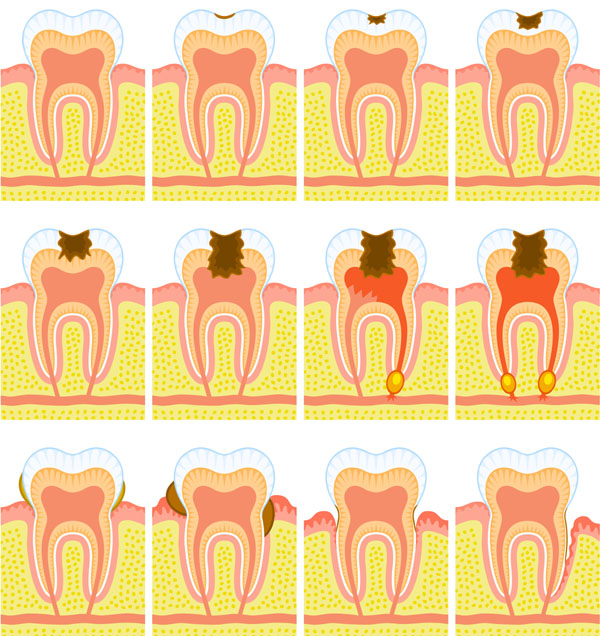
The
main purpose for this page is to motivate all of us to
keep our teeth at picture #1 or healthy teeth surrounded
by healthy gum.
Let's
walk through the life of a tooth. Do all teeth have to
go through this process? No, when archeologists find human
skull and teeth, their teeth could still be intact. I
bet human never have so much sugar, high fructose corn
syrup, acidic food and beverages.
I
have two questions for you.
Question
#1. Which picture best describes your teeth and your gum?
Question
#2. Which picture do you want your teeth and your gum
to look like?
Need a little help? Let's talk about what each picture
means.
In
dentistry, we deal with two major diseases: cavity or
tooth decay and gum disease.
Picture
#1 Healthy Tooth
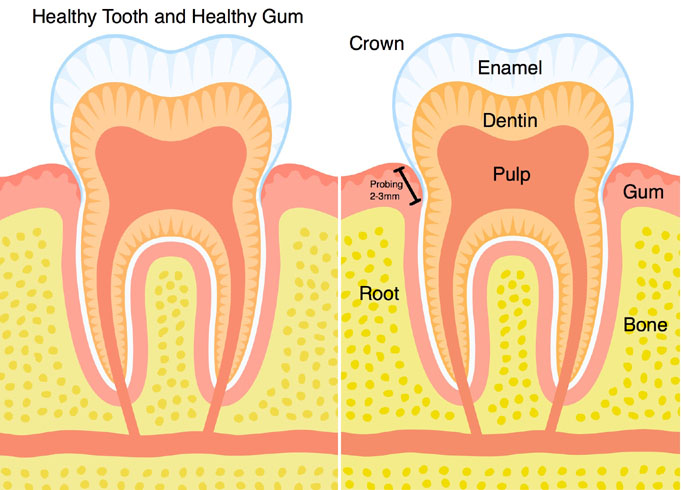
Note
from Eric:
This is the artistic representation of a molar. I really
love this series of pictures. Not perfect, but comfortable
enough to look at. Feel free to share this link with your
friends, family, co-workers and whoever would find useful.
If it generates like a million hits, I will be happy to
pay the artist loyalty.
The
crown portion is exposed in the mouth. The root portion
is anchored by the bone underneaths the gum.
A
tooth has couple layers.
The
outer layer is called enamel. Enamel is the toughest substance
in our body. Usually white or somewhat transparent.
Dentin
is the next layer. It is much softer. It is more yellowish.
The
next layer is the pulp where the nerve and blood supply
is. Bacteria loves these nutrients.
The
nerve and blood supply connects to our whole body.
The
gum (both the darker and ligher red) is hugging the tooth
tightly. Normally, there is a space between 2-3mm. When
we are checking your probing depth, your healthy gum will
read 2's or 3's.
And
the bone (yellow with dots) is at a good level.
Keep
in mind, your Xray shows these layers in greyscale. If
you want, ask us to show you the different layers. At
the same time, allow us to ask you if we can post your
Xray (no name or ID) here for educational purpose.
Question:
Do you think your teeth look like picture #1?
Do you want your teeth to look like picture #1?
Picture
#2
Enamel Cavity
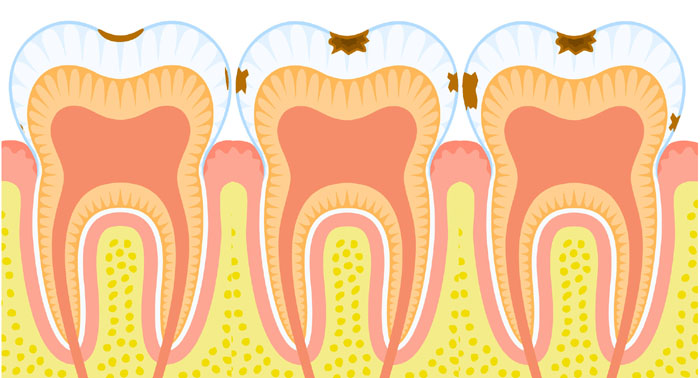
Small
cavity that is still in the enamel.
Yellow/brown/black stain. Darker stain usually means deeper
cavity.
Eric's
note: In my early career, I thought bacteria is so smart.
They manage to hide in some of the hardest to reach spot.
Then I quickly realize bacteria and food are everywhere.
You can brush them away. If you leave some bacteria behind
for an extended period of time, cavity develops. Let Eric
find out if you are missing any spot.
On
the biting surface, pits and grooves or what dentists
called fissures can hide bacteria. In general, as long
as the surface is still strong and sound, your tooth does
not need work done yet.
Food
and bacteria can stay in between our teeth and around
the gum line. Notice how thin the enamel around the gum
line.
If
I mentioned to watch some spots on your teeth, a smart
person would spend more time brushing and flossing those
spots to keep the cavity small. NOTE: I did not say brush
harder. I said to brush longer (2 minutes) and make sure
you reach the last teeth.
Some
dietary adjustment will be beneficial too. If you can
live with just water and cheese, good for you.
For
everybody else, avoid sugar and acidic food or beverages
including soda, anything carbonated, sticky candy and
food such as raisins, even juice and citrus fruits are
acidic and sports drink is both acidic and full of sugar.
Duration
and frequency
For
those of you who need these sugar food to survive, I highly
recommend switching to water. Swallow any sugar and acid
as soon as possible and drink some water to wash away
the food.
Also,
you can still eat the same amount, but cut down the number
of trips you have snack. And get everything into your
stomach.
Couple
points:
Question:
Do you think your teeth look like picture #2?
Do you want your teeth to look like picture #2?
Picture
#3
Dentin Cavity
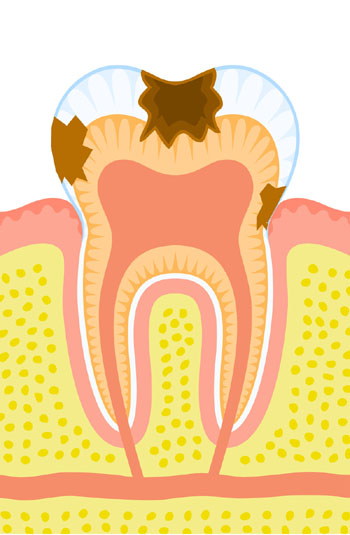
Now
the bacteria works its way into the dentin. Since dentin
is a lot softer, bacteria can spread very fast in all
directions. Sensitivities to sweet and temperature may
occur. Since cavity develops slowly, your body could adapt
to the sensation and you may not feel anything.
Note:
Advanced information. Feel free to skip this paragraph
if too overwhelming.
The cavity and fillings are classified based on the number
of surfaces. If you hold a fist up. There are five surfaces
facing different directions: buccal (facial), lingual,
mesial, distal, occlusal (incisal). The sixth surface
is the forearm or the root. The short forms are: B (F),
L, M, D, O (I). Dr. Eric may say something like “MOD
on tooth #3.” The cavity is involved with three
surfaces. Most general dentists in the US use the numbering
system from 1 to 32 for permanent teeth and A to T for
twenty baby teeth. The number starts from the top right
side, the upper right wisdom tooth is #1, second molar
is #2... the top left wisdom tooth is #16, the lower left
wisdom tooth is #17... the lower right wisdom tooth is
#32. The alphabet starts from the upper right second baby
molar #A to lower right second baby molar #T.
END
OF ADVANCED INFORMATION
In
general, the more surfaces, the bigger the cavity, the
longer to restore and the higher the cost too.
During
the dental exam, your tooth will feel soft and sticky.
In this case, we need to remove the cavity and do a filling.
Not enough tooth structure will need a buildup and a crown.
During
the treatment appointment, if the cavity is too close
to the pulp, where the nerve is, Eric will recommend to
place a liner or pulp cap to lessen the chance to have
sensitivities afterward. We will explain in picture #4
if cavity reaches the pulp.
Question:
Do you think your teeth look like picture #3?
Do you want your teeth to look like picture #3?
Picture
#4
Cavity to pulp
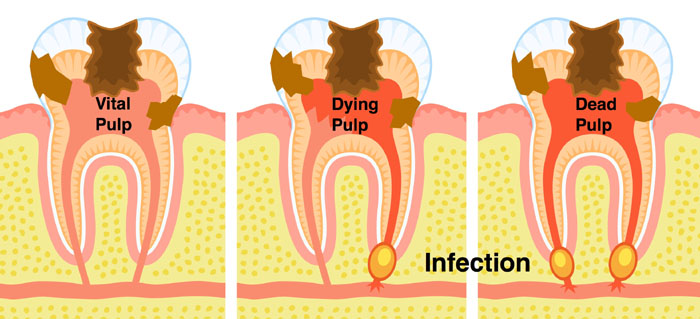
When
the cavity go into the pulp, you will not be reading this
and you will be calling all dentists to get treatment.
Just in case, my office number is (209) 358-0800.
The
confusing thing is this pain could disappear for awhile
and then come back. Let's solve this mystery.
When
bacteria first reaches the pulp, your nerve will signal
pain. Our body will try to fight it. However, the end
of the root is restricted and limits immune cells to do
their job. To make matter worse, all the nutrients will
speed up bacterial growth. More bacteria and more pain
up to a point until the nerve is dead. The nerve or part
of the nerve can no longer feel, so the pain goes away.
Unfortunately, bacteria will stay and advance towards
the end of the root.
Once
the bacteria works its way down to the end of the root,
bacteria will cause an infection. Smelly puss could start
coming out. The cheek or other area in the head and neck
area could swell up. And the pain will not go away unless
the tooth receives treatment.
Question:
Do you think your teeth look like picture #4?
Do you want your teeth to look like picture #4?
Picture
#5
is blank
There is no tooth
Here
are some reasons:
Reference: CDC website
regarding periodontal disease
Ready
for some pictures?
Picture
#1 Healthy Tooth

Healthy tooth and health gum does not have much food and
bacteria buildup. Healthy gum does not bleed. Good bone
support.
Question:
Do you think your gum look like Picture #1?
Do you want your gum to look like Picture #1?
Picture
#A Gingivitis
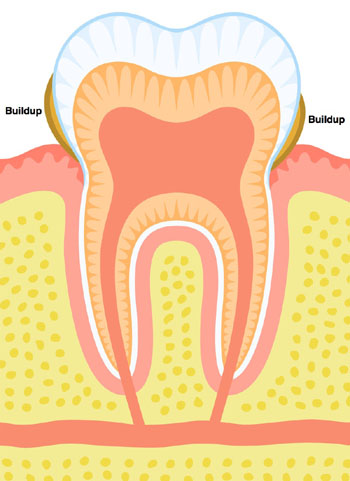
The
brown thing around the tooth is food, bacteria, plaque,
tartar and anything else that sticks to it. At this stage,
the gum is red and sometimes bleeds when brushing and
flossing.
The
good news is gingivitis is still reversible. Don't let
it develops into more advanced disease: periodontistis.
Notice
not much buildup around the upper half of the crown. With
some decent brushing, the plaque will not stay on most
part of the crown. Plus saliva and tongue can move most
food away. The trouble spots are always the cheek and
tongue side near the gum line and also area in between
teeth. That's why we teach to brush around the gum line
at a 45 degree angle. Once again, not brushing harder,
but brushing longer time-wise and reaching all the way
to the last teeth. Don't forget flossing.
Question:
Do you think your gum look like picture #A?
Do you want your gum to look like picture #A?
Picture
#B Mild to moderate gum disease
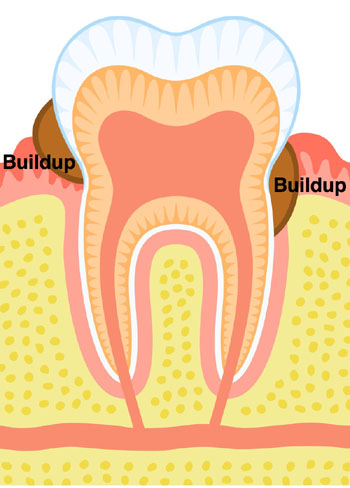
The
gum is definitely more red and swollen. The bacteria,
food and plaque become calcified to become tartar. And
the gum is peeling away, so more bacteria, food, plaque
and tartar go deeper into the root.
This
is the stage to have gum recession too. With all these
dirty things, the gum does not want to come close and
run away. The trouble is without the gum, the root surface
is exposed. Root surface is like dentin, or much softer.
The tooth gets cavity easier and bacteria grows faster
too.
Brushing
too hard, grinding and clenching, acid erosion, biting
fingernail, pencil or other things could also damage the
gum to expose the root.
At
this stage, treatment involves scaling and root planing
or deep cleaning to remove those tartar to give the gum
a chance to heal. At the same time, good home care is
very important.
Question:
Do you think your gum look like picture #B?
Do you want your gum to look like picture #B?
Picture
#C After deep cleaning
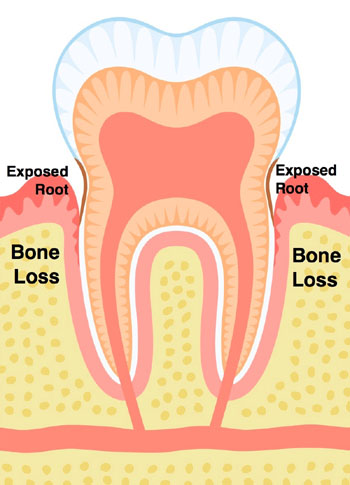
After deep cleaning,
the gum is healing. But probably just a little too late,
do you notice the bone loss? The level of the bone is
not as high as before. Do you see the exposed root surface
(cementum)? The gum is definitely further away from the
tooth.
Bone regeneration
is not as predictable. The specialist usually have to
put some bone and gum tissue back. The specialist charges
even more.
Along with good home
care, this tooth could still last for awhile.
Question:
Do you think your gum look like picture #C?
Do you want your gum to look like picture #C?
Picture
#D Advanced stage of gum disease
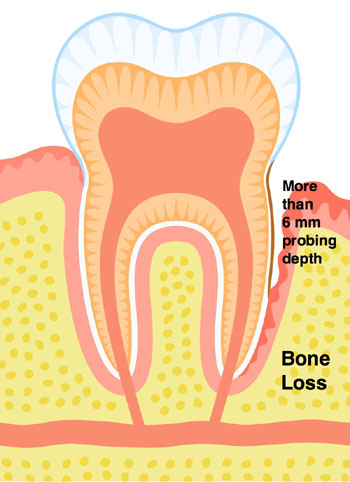
This is the advanced stage
of gum disease. The gum is far away from the tooth. The
brown line shows where the bacteria is. Keep in mind,
food, plaque and tartar is present along that brown line.
Even more bone loss (not shown as much in the picture).
When we probe, you will hear
numbers beyond 6. Usually the length of the root is between
10-15mm. When a person has 9 mm pocket and 3 mm gum recession,
there is only 3mm of gum or bone to hold onto the tooth.
No wonder that tooth will move and fall off.
Treatment involves the care
of the specialist. And sometimes unfortunately, the teeth
are hopeless and best with extraction and possibly an
implant, bridge, or partial or denture to replace that
missing tooth/teeth.
Question:
Do you think your gum look like picture #D?
Do you want your gum to look like picture #D?
So, the choice is your.
Question #1. Which picture
best describes your teeth and your gum?
Question
#2. Which picture do you want your teeth and your gum
to look like?
Back
to top
Oral
Hygiene
Oral
hygiene is very important. We want to continue to smile,
chew, and talk without any discomfort. Brush twice a day
for two minutes, floss every day, and visit your dentist
every 6 months will bring great benefit to your health.
Here are some flyers. Feel free to click on the pdf files
to read them all.
FS_BrushingBasics.pdf
Brushing your teeth two times a day is an important part
of your daily oral hygiene routine. Check out the flyer
FS_FamilyOralHealth.pdf
Children learn by example. Lead your kids and family to
good oral health. Check out the flyer.
FS_Flossing.pdf
Here is your how, when and why guide to flossing your
gums to a state of health. Check out the flyer.
FS_Mouthwash.pdf
Mouthwashes are not a necessity to a healthy mouth, but
there are several out there that can help you prevent
cavities and reduce sensitivity. It is definitely an addition,
not a substitution to brushing and flossing. Check out
the flyer.
FS_OralHygiene.pdf
Floss First, Brush Second! Keep you healthy. Check out
the flyer.
FS_Plaque.pdf
Plaque is a live bacteria that lives in your mouth. Learn
how to control the acid byproduct bacteria leaves in your
mouth. Check out the flyer.
FS_Toothbrushes2.pdf
Size and shape does matter! Choose the brush that fits
your needs. Check out the flyer.
FS_ToothpasteAbrasivity.pdf
So many toothpaste choices. Educate yourself on what is
available for you. Check out the flyer.
FS_Xylitol.pdf
Xylitol is one of the best kept secrets. Read on to find
what you can do to reduce cavities. Check out the flyer.
Back
to top
Different
Signs
Our
body gives us signs to warn us. Your mouth shows signs
too. Let us explore what some of those signs mean. Catch
them early, so we can prevent future problems.
BruxismFS.pdf
Teeth occasionally sore or sensitive to cold? Headaches?
Cracks in teeth? You may be clenching or grinding your
teeth. Check out the flyer.
FS_Allergies_and_Dentistry.pdf
Some allergic reactions are mild, while others can be
severe and life-threatening. Please inform our dental
staff of any allergy you have. Check out the flyer.
FS_CancerCare.pdf
Cancer treatments affect your oral health. Consult your
dental office for advice prior to your treatment. Check
out the flyer.
FS_DentinHypersensitivity.pdf
Do you avoid cold drinks or food? Don't let acid erode
away your teeth. Check out the flyer.
FS_DryMouthX.pdf
Do you always feel your mouth dry? Saliva is a very important
buffer. Many medications reduces salivary flow and cause
cavities. Check out the flyer.
FS_EatingDisorders.pdf
Eating disorders are real, complex, and often devastating
conditions that can have serious consequences on your
overall health and oral health. Check out the flyer.
FS_Halitosis.pdf
Bacterial waste is the #1 cause of bad breath: Flossing
& Brushing (your tongue too) to reduce bacteria and
please do not let cavities grow. Check out the flyer.
FS_MouthSores.pdf
Mouth sores are swollen spots or sores in your mouth,
on your lips, on your tongue, or on the skin surrounding
your mouth. Check out the flyer.
FS_OralCancer.pdf
Reduce your risks of oral cancer. Quit smoking and drinking.
HPV in men and women are causing oral cancer! Check out
the flyer.
FS_SleepApnea.pdf
Are you gasping for air in your sleep? Ask your physician
to do a sleep study. Talk to me if you know you need a
CPAP, but refuses to use one even if you know the consequences.
Check out the flyer.
FS_ToothErosion.pdf
Tooth wear can happen from diet, acid reflux, grinding/clenching
or brushing too hard. Acidic food and drinks can cause
tooth erosion and tooth sensitivity. Check out the flyer.
FS_WisdomTeeth.pdf
Wisdom teeth are usually removed done to decay, infection,
or impaction. One of the worst thing is to wait too long
and the wisdom tooth erupts sideway and damage the second
molar. Now both teeth need to be removed. Check out the
flyer.
Back
to top
Dangerous
things you may not know about
FS_DentalEmergencies_2.pdf
Learn what to do before you encounter an emergency. And
if dental emergency ever occurs during off hours, call
911, text my office and facebook message my office. Check
out the flyer.
FS_DentalEmergencies.pdf
Dental emergency is so important and let's review again.
Check out the flyer.
FS_E-Cigarettes.pdf
E-cigarettes are not an alternative. Read about ways to
quit smoking. Check out the flyer.
FS_EffectsofSmoking08.pdf
Using tobacco can harm your mouth, including your teeth
and gums, in a number of ways. How does yellow and brown
teeth, gum disease, cancer make you attractive? Check
out the flyer.
FS_OralPiercing_Dec13.pdf
Oral piercing cause damage to your teeth as well as your
soft tissues in your mouth. Check out the flyer.
FS_OralWarningSigns.pdf
Your mouth is the opening to your entire body. How does
diabetes, eating disorders, alcohol use disorders, and
cancer affect the mouth? Check out the flyer.
Back
to top
Do
you fit the following description?
FS_DentalAnxiety.pdf
Going to the dentist can cause anxiety, and that’s
a normal reaction. Tell your dental team of your anxiety
they will help make a plan to ease your stress. Check
out the flyer.
FS_Geriatric_Dental_Care.pdf
Aging doesn't mean losing your teeth. Like everyone else
we just have to learn how to keep your mouth healthy as
we age. Check out the flyer.
FS_MensOralHealth.pdf
Men are less likely than women to take care of their physical
health and, according to research, their oral health is
equally ignored. Don't let the tiny bacteria beat you
up. Check out the flyer.
FS_Pregnancy.pdf
Thinking about getting pregnant. Take care of your teeth
first. Dental work during pregnant is doable, but why
put the baby in any avoidable risk. At the same time,
being pregnant doesn't mean no dental appointment and
no dental work ever. Please inform us if you are pregnant
or possibly pregnant. Check out the flyer.
FS_WomensOralHealth.pdf
Learn how to adjust your oral health depending the stage
of life you are in. Check out the flyer.
Back
to top
How
your mouth relates to the rest of your body
FS_Endocarditis.pdf
Understanding endocarditis and when antibiotics are taken
prior to dental procedures. Check out the flyer.
FS_GERD.pdf
Heartburn, or acid indigestion, is a common symptom of
chronic acid reflux, also known as gastroesopheageal reflux
disease (GERD). Acid reflux can cause enamel errosion
leading to sensitivity. Check out the flyer.
FS_Nutrition.pdf
What you put in your mouth directly affects your whole
body. Check out the flyer.
FS_Perio_and_diabetes.pdf
Periodontal Disease and Diabetes
Diabetic develops infections faster and heals slower than
people without diabetes. Check out the flyer.
FS_PeriodontalCardiovascular.pdf
Periodontal Disease and Cardiovascular Disease
Control your periodontal disease and reduce the risk of
cardiovascular disease. Check out the flyer.
FS_PeriodontalDisease.pdf
Periodontal Disease ?Minimize your chances of periodontal
disease by seeing your hygienist; flossing and brushing
regularly. Check out the flyer.
Back
to top
Our
children's teeth
From
infants to young adults, how can you help them to stay
healthy.
FS_BabysOralHealth.pdf
It's never too early to start taking care of your little
one's teeth. If you love your kids, don't kiss on their
lip. You will give bacteria to them. Check out the flyer.
FS_ChildrenandToothDecay.pdf
Tooth decay is the most common chronic disease among children.
Learn about prevention. Check out the flyer.
FS_ChildrensOralHealth.pdf
Set the stage for your children's lifelong oral health.
Lead by example too. Check out the flyer.
FS_ChildsFirstDentalVisit.pdf
Come early, bring kids with you to your visit so they
know what to expect. Check out the flyer.
FS_DentalSealants.pdf
When the teeth are still forming, teeth have grooves and
depression. Seal those grooves and depressions to prevent
cavities. No anesthetics needed. Check out the flyer.
FS_FASD.pdf
Drinking alcohol while pregnant may cause life long birth
defect. Just don't do it! Check out the flyer.
FS_Nutrition_Children.pdf
Teach your children to make healthy food decisions. Check
out the flyer.
FS_Pacifiers.pdf
Pacifier is controversial in dentistry. I have heard of
wean children off as early as six months to six years
old. Without pacifier, they might suck on their finger
instead. Try to figure out if the baby is having stress
and smooth more. Check out the flyer.
FS_SportsDentistry.pdf
A custom guard can prevent many injuries to teeth, neck
and jaw. Check out the flyer.
Orthodontics_FS.pdf
Want to learn more about braces? Check out the flyer.
TeensFS.pdf
Teen's Oral Health
Teens should be sure to see their dentist at least twice
a year. Check out the flyer.
Back
to top
Procedures
FS_Bridges.pdf
A fixed bridge is a dental appliance that replaces one
or more missing teeth—thus “bridging”
the space between the two adjacent natural teeth or implants.
Check out the flyer.
FS_CosmeticDentistry.pdf
Different ways to improve your smile and confidence. Check
out the flyer.
FS_Crowns.pdf
Crowns or caps can be the lasting restoration your mouth
needs. Check out the flyer.
FS_Dental-Implants.pdf
Dental implant is the closest thing to the missing tooth.
No wonder it is the best option. Check out the flyer.
FS_Dentures.pdf
Learn what to expect prior to getting dentures. Need care
& occasional checkups. Check out the flyer.
FS_Mouthguards.pdf
One elbow to the mouth will drive home. Custom-fabricated
mouthguards are essential for preventing athletic oral/facial
injuries, such as broken teeth, jaw fractures, cerebral
hemorrhages, and neck injuries. Check out the flyer.
FS_RootCanalTherapy.pdf
Want to learn more about root canal treatment? Check out
the flyer.
FS_Sedation.pdf
Help us Help you! If you riddled with anxiety, let's find
a good solution prior to your visit. Check out the flyer.
FS_TMD.pdf
Temporomandibular Disorder
(TMD) occurs when the temporomandibular joint (TMJ) is
damaged or deteriorated, or when the muscles surrounding
the joint malfunction, causing imbalanced jaw movement.
Jaw joint pain is terrible! Learn about TMD and what you
can do to help with the pain. Check out the flyer.
FS_ToothExtraction.pdf
Teeth are usually extracted because decay and damage has
left the tooth unable to be repaired through other methods.
Learn what to expect if you need an extraction. Check
out the flyer.
Back
to top
Call
Atwater Family Dental today and schedule your next dental
appointment so we can keep it at picture #1.
Healthy teeth surrounded by healthy gum..
Give us a call today, you deserve it, 209.358.0800.
(Best time to reach us: 9am to 1pm, 2pm-4:30pm Monday
to Thursday)

Or
text us at 209.358.0800
Or fill
in your information
and we will call you to schedule your next appointment.